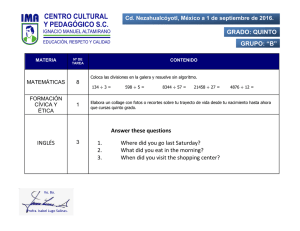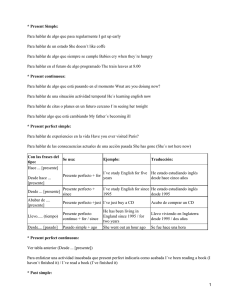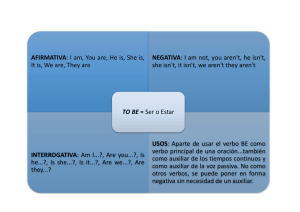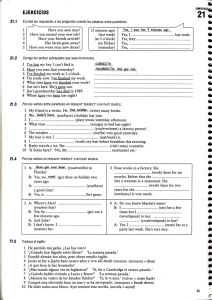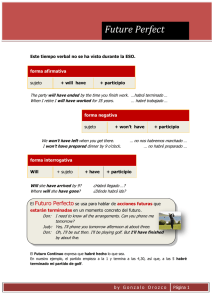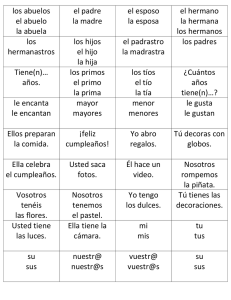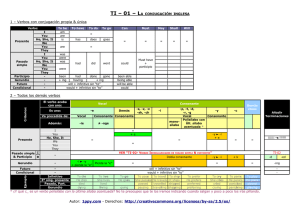Repaso a los tiempos verbales
Anuncio
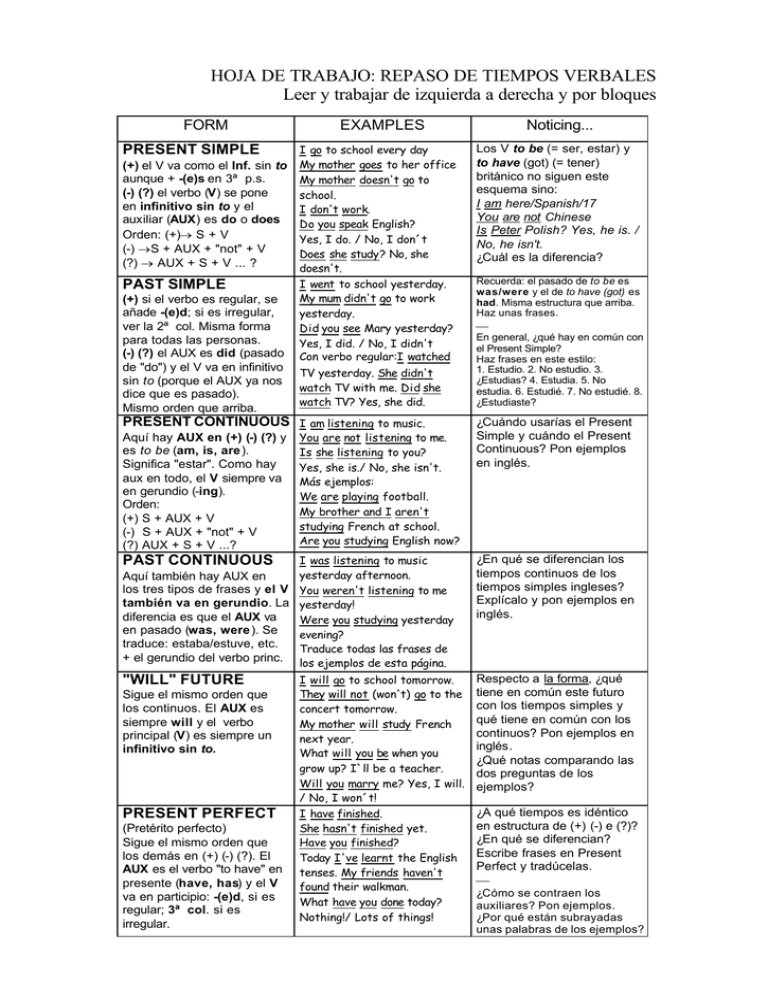
HOJA DE TRABAJO: REPASO DE TIEMPOS VERBALES Leer y trabajar de izquierda a derecha y por bloques FORM PRESENT SIMPLE (+) el V va como el Inf. sin to aunque + -(e)s en 3ª p.s. (-) (?) el verbo (V) se pone en infinitivo sin to y el auxiliar (AUX) es do o does Orden: (+)→ S + V (-) →S + AUX + "not" + V (?) → AUX + S + V ... ? PAST SIMPLE (+) si el verbo es regular, se añade -(e)d; si es irregular, ver la 2ª col. Misma forma para todas las personas. (-) (?) el AUX es did (pasado de "do") y el V va en infinitivo sin to (porque el AUX ya nos dice que es pasado). Mismo orden que arriba. PRESENT CONTINUOUS Aquí hay AUX en (+) (-) (?) y es to be (am, is, are). Significa "estar". Como hay aux en todo, el V siempre va en gerundio (-ing). Orden: (+) S + AUX + V (-) S + AUX + "not" + V (?) AUX + S + V ...? PAST CONTINUOUS Aquí también hay AUX en los tres tipos de frases y el V también va en gerundio. La diferencia es que el AUX va en pasado (was, were). Se traduce: estaba/estuve, etc. + el gerundio del verbo princ. "WILL" FUTURE Sigue el mismo orden que los continuos. El AUX es siempre will y el verbo principal (V) es siempre un infinitivo sin to. PRESENT PERFECT (Pretérito perfecto) Sigue el mismo orden que los demás en (+) (-) (?). El AUX es el verbo "to have" en presente (have, has) y el V va en participio: -(e)d, si es regular; 3ª col. si es irregular. EXAMPLES Noticing... I go to school every day My mother goes to her office My mother doesn't go to school. I don't work. Do you speak English? Yes, I do. / No, I don´t Does she study? No, she doesn't. I went to school yesterday. My mum didn't go to work yesterday. Did you see Mary yesterday? Yes, I did. / No, I didn't Con verbo regular:I watched TV yesterday. She didn't watch TV with me. Did she watch TV? Yes, she did. Los V to be (= ser, estar) y to have (got) (= tener) británico no siguen este esquema sino: I am here/Spanish/17 You are not Chinese Is Peter Polish? Yes, he is. / No, he isn't. ¿Cuál es la diferencia? I am listening to music. You are not listening to me. Is she listening to you? Yes, she is./ No, she isn't. Más ejemplos: We are playing football. My brother and I aren't studying French at school. Are you studying English now? ¿Cuándo usarías el Present Simple y cuándo el Present Continuous? Pon ejemplos en inglés. I was listening to music yesterday afternoon. You weren't listening to me yesterday! Were you studying yesterday evening? Traduce todas las frases de los ejemplos de esta página. ¿En qué se diferencian los tiempos continuos de los tiempos simples ingleses? Explícalo y pon ejemplos en inglés. I will go to school tomorrow. They will not (won't) go to the concert tomorrow. My mother will study French next year. What will you be when you grow up? I`ll be a teacher. Will you marry me? Yes, I will. / No, I won´t! I have finished. She hasn't finished yet. Have you finished? Today I've learnt the English tenses. My friends haven't found their walkman. What have you done today? Nothing!/ Lots of things! Respecto a la forma, ¿qué tiene en común este futuro con los tiempos simples y qué tiene en común con los continuos? Pon ejemplos en inglés. ¿Qué notas comparando las dos preguntas de los ejemplos? Recuerda: el pasado de to be es was/were y el de to have (got) es had. Misma estructura que arriba. Haz unas frases. En general, ¿qué hay en común con el Present Simple? Haz frases en este estilo: 1. Estudio. 2. No estudio. 3. ¿Estudias? 4. Estudia. 5. No estudia. 6. Estudié. 7. No estudié. 8. ¿Estudiaste? ¿A qué tiempos es idéntico en estructura de (+) (-) e (?)? ¿En qué se diferencian? Escribe frases en Present Perfect y tradúcelas. ¿Cómo se contraen los auxiliares? Pon ejemplos. ¿Por qué están subrayadas unas palabras de los ejemplos?

